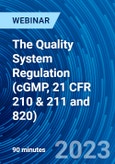What are U.S. FDA CGMP requirements for the manufacture of medical devices for sale in the US? Discuss the key Quality System Regulation/Quality Management System requirements of 21 CFR 820, Quality System Regulation.
This webinar will examine the 14 key elements of the Medical Device CGMPs, 21 CFR 820, the Quality System Regulation, the 7 key elements, and the defining 4 elements, as defined and evaluated by the FDA's QSIT. Product development and manufacturing ("realization") and its compliance and documentation. Design Control, the Device History File, the Device Master Record and the Device History Record are defined. Corrective and Preventive Action (CAPA) requirements and key components. Production and Process Control (P&PC) expectations. Verification and Validation, including software - Why and How? Differing approaches to compliance inspections/audits internally by the company and externally by the FDA.
Why Should You Attend
Global companies must meet US FDA 21 CFR 820 (The QSR) requirements in order to sell such devices in the US, no matter where they are manufactured. These companies must pass FDA compliance inspections (audits) to 21 CFR 820. The cGMPs mandate 15 key systems and procedures that must be followed and documented to allow cleared/approved products to be sold commercially in the US. Of those 15, the FDA focuses on 7, and places extreme emphasis on 4, per QSIT. Why? What does compliance look like? What are the benefits to the company for compliance? What role do the Risk Management File (ISO 14971) and Use Engineering File (IEC 62366-1) play in conformance and day-to-day compliance? How does failure to comply result in adulterated products, 483 Observations, Warning Letters, and worse? What are the key components of a CGMP-compliant QMS, a Risk Management File, and a Use Engineering/Human Factors File, and their interrelationships?
Webinar Takeaway
- The U.S. FDA's 21 CFR 820, the QSR, the Device CGMPs/QMS, QSIT
- The Documentation Requirements
- Design Contol; Risk Management, and Human Factors/Use Engineering
- Management Responsibility
- Production and Process Controls
- CAPA
- DHF Required Contents
- The Risk Management File (ISO 14971) and its role
- The Use Engineering File (IEC 62366-1) and its role
- Expected QMS Records
- The DMR and DHR
- FDA Inspection/Audit Focus
Speakers

John E. Lincoln,
Principal Consultant ,
J. E. Lincoln and Associates LLCJohn E. Lincoln is principal of J. E. Lincoln and Associates LLC, a consulting company, with over 33 years’ experience in U.S. FDA-regulated industries and 20 years as a full-time consultant. He has worked with companies from start-up to Fortune 100, in the U.S., Mexico, Canada, France, Germany, Sweden, China and Taiwan.
He specializes in quality assurance, regulatory affairs, QMS problem remediation and FDA responses, new / changed product 510(k)s, process/ product/ equipment including QMS and so+E6ftware validations, ISO 14971 product risk management files / reports, design control / design history files, and technical files. He's held positions in manufacturing engineering, QA, QAE, regulatory affairs, to the level of director and VP (R&D). In addition, Mr. Lincoln has prior experience in military, government, electronics, and aerospace. He has published numerous articles in peer reviewed journals, conducted workshops and webinars worldwide on CGMP subjects. He is a graduate of UCLA.
Who Should Attend
- Senior management
- Regulatory Affairs
- Quality Assurance
- Production
- All personnel involved in the U.S. FDA-regulated medical device spec development, and manufacturing environments. Especially those involved in new medical device / combination product development, line extensions, and incremental product improvements; having to evaluate those changes in light of the DHF / CGMPs, and then document these actions in harmony with the regulations.








